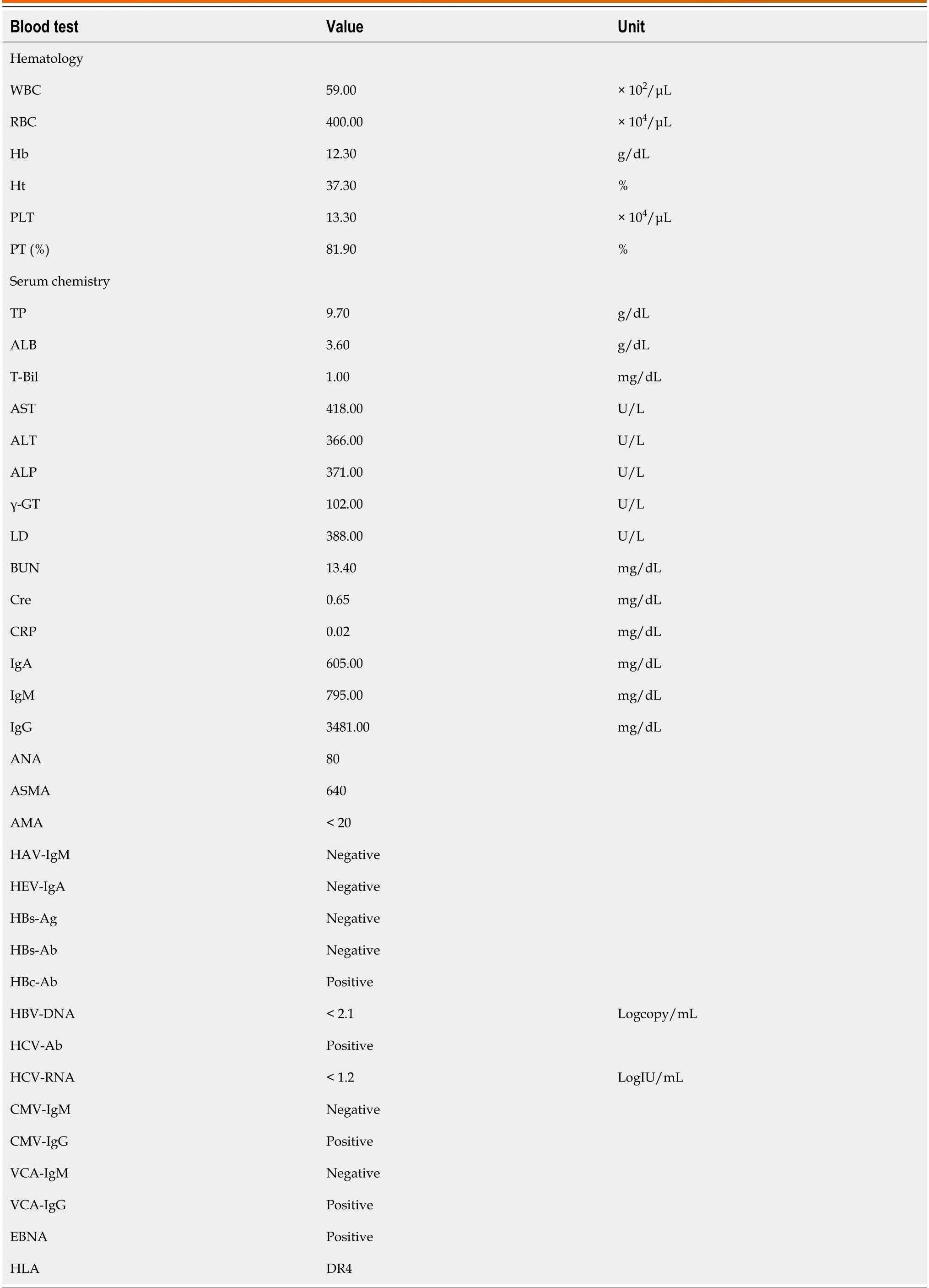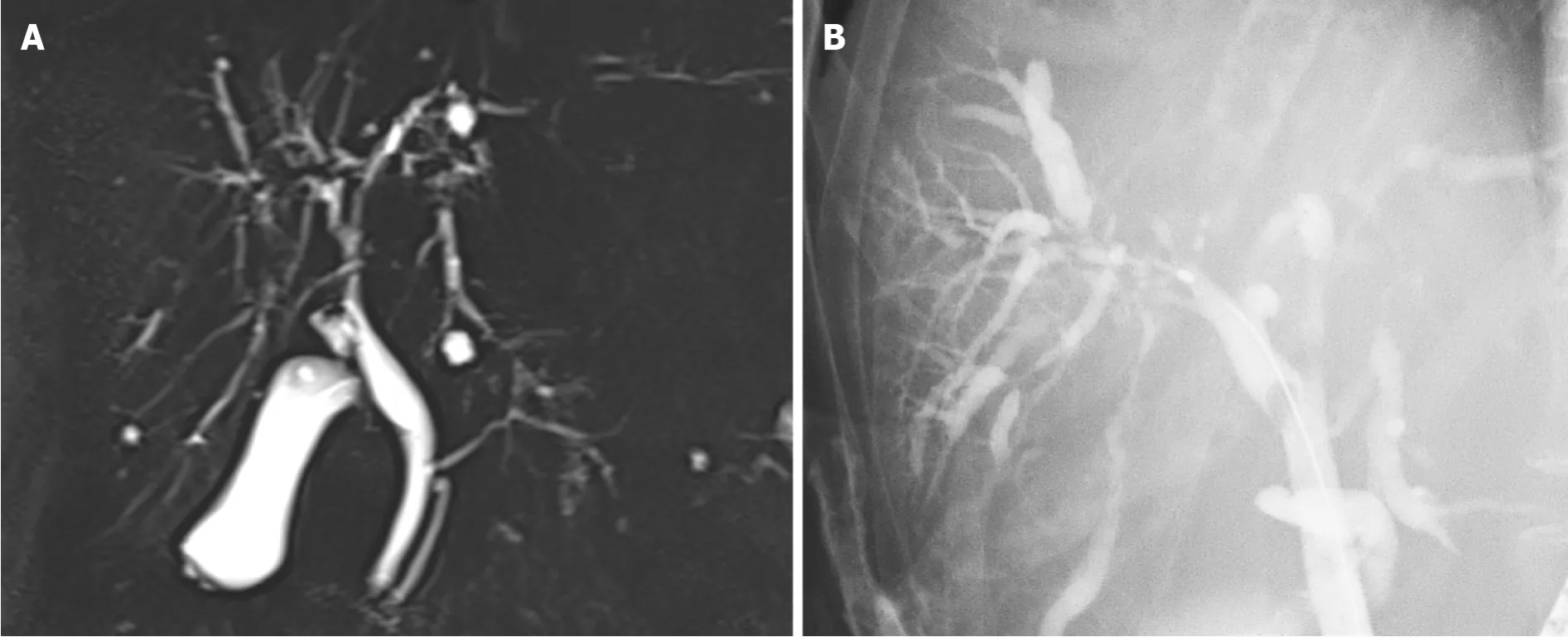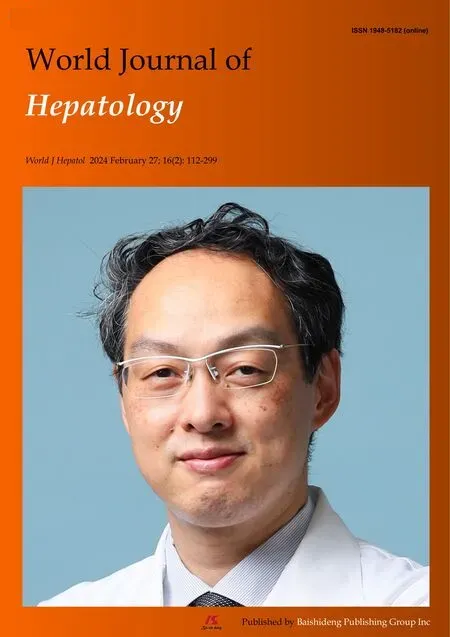Autoimmune hepatitis and primary sclerosing cholangitis after direct-acting antiviral treatment for hepatitis C virus: A case report
Yoshiki Morihisa,Hobyung Chung,Shuichiro Towatari,Daisuke Yamashita,Tetsuro Inokuma
Abstract BACKGROUND Chronic hepatitis C virus (HCV) infection is a major global health concern that leads to liver fibrosis,cirrhosis,and cancer.Regimens containing direct-acting antivirals (DAAs) have become the mainstay of HCV treatment,achieving a high sustained virological response (SVR) with minimal adverse events.CASE SUMMARY A 74-year-old woman with chronic HCV infection was treated with the DAAs ledipasvir,and sofosbuvir for 12 wk and achieved SVR.Twenty-four weeks after treatment completion,the liver enzyme and serum IgG levels increased,and antinuclear antibody became positive without HCV viremia,suggesting the development of autoimmune hepatitis (AIH).After liver biopsy indicated AIH,a definite AIH diagnosis was made and prednisolone was initiated.The treatment was effective,and the liver enzyme and serum IgG levels normalized.However,multiple strictures of the intrahepatic and extrahepatic bile ducts with dilatation of the peripheral bile ducts appeared on magnetic resonance cholangiopancreatography after 3 years of achieving SVR,which were consistent with primary sclerosing cholangitis.CONCLUSION The potential risk of developing autoimmune liver diseases after DAA treatment should be considered.
Key Words: Liver;Hepatitis C virus;Autoimmune hepatitis;Primary sclerosing cholangitis;Immune system;Case report
INTRODUCTION
Hepatitis C virus (HCV) infection is a growing international concern because of its substantial morbidity and mortality.HCV has a worldwide prevalence of 0.7%,infecting over 56.8 million people,with approximately 1.5 million new infections every year[1].Most patients (50%-90%) develop chronic infections and chronic liver diseases,such as cirrhosis,liver failure,and hepatocellular carcinoma[2].Pegylated interferon alpha and ribavirin administration was the basis of the antiviral therapy for HCV;however,the frequent side effects and poor treatment outcomes were problematic[3-5].In 2013,the first interferon-free treatment regimen was approved for the treatment of chronic hepatitis C (CHC) and several other direct-acting antivirals (DAAs) have been developed since.Such DAA regimens present excellent safety profiles and high response rates,which exceed 97% not only in clinical trials,but also in real-world clinical settings.As a result,most patients with CHC have achieved sustained virological response (SVR)[6,7].
Recently,various studies have focused on the functional changes of the immune system induced by the rapid viral clearance of DAAs after chronic HCV infections,and some reports have demonstrated the recovery of innate and adaptive immune responses after the SVR[8].Interestingly,some case reports have described patients who developed autoimmune hepatitis (AIH) after DAA treatment for HCV,suggesting that the recovery of host immunity is associated with the development of autoimmune liver disorders.
Herein,we report a rare case of a woman with CHC who developed AIH and primary sclerosing cholangitis (PSC)after antiviral therapy with DAA.
CASE PRESENTATION
Chief complaints
A 74-year-old woman visited our department for the treatment of HCV infection.
History of present illness
She was administered a 12-wk combination regimen of sofosbuvir (SOF) and ledipasvir (LDV) and achieved SVR.Twenty-four weeks after treatment completion,the liver enzyme levels increased.
History of past illness
She had a history of ectopic pregnancy and had received a blood transfusion 50 years before.
Personal and family history
She had no remarkable family history or history of autoimmune diseases.She had a history of smoking and consumed 350 mL of beer once a week.
Physical examination
She denied having fever or chills,malaise,or fatigue but presented discrete weight loss.
Laboratory examinations
Laboratory examinations showed an undetectable serum HCV RNA;however,serum aspartate aminotransferase (AST)and alanine aminotransferase (ALT) levels were elevated at 335 U/L and 329 U/L,respectively (Table 1).The total bilirubin level was not increased,and prothrombin time was not prolonged.The serum IgG level was increased at 3481 mg/dL.The antinuclear antibody (ANA) and antismooth muscle antibody (ASMA) titers were 1:80 in a homogeneouspattern and 1:640,respectively,whereas the antimitochondrial antibody (AMA) was negative.Notably,ANA and ASMA were negative before the start of the DAA regimen,yet the titers of both antibodies gradually increased during and after treatment (Table 2).

Table 1 Blood test

Table 2 Blood test results (antinuclear antibody and antismooth muscle antibody)
Imaging examinations
Contrast-enhanced computed tomography revealed no abnormal findings at the time of exacerbation.Liver biopsy examination showed inflammatory cell infiltration mainly composed of lymphocytes and plasma cells in the portal and lobular areas and severe interface hepatitis with rosette formation (Figure 1A and B).

Figure 1 Initial and second liver biopsy. A and B: The initial liver biopsy showing inflammatory cell infiltration mainly composed of lymphocytes and plasma cells in the portal and lobular areas,and severe interface hepatitis with rosette formation.Hematoxylin and eosin staining (HE: A,× 100;B,× 200);C and D: A second liver biopsy shows improvement of the interface hepatitis,yet a massive infiltration of lymphocytes and plasma cells is noted.B and D are magnified images of the yellow square in A and C,the black arrow shows the proliferation of interlobular bile ducts in the portal triad area (HE: C,× 100;D,× 200).
FINAL DIAGNOSIS
The definite diagnosis of AIH was made according to the International Diagnostic Criteria and Simplified Criteria for AIH,based on laboratory tests and liver biopsy findings,with scores of 18 and 8 points,respectively.
TREATMENT
After the AIH diagnosis,a daily 20 mg (0.5 mg/kg) dose of prednisolone was started.Serum AST,ALT,and IgG levels decreased significantly and reached normal limits (Figure 2).Daily 600 mg ursodeoxycholic acid (UDCA) doses were administered along with tapering of the prednisolone dose.Remission of AIH and normalization of serum AST,ALT,and IgG levels were maintained with daily doses of prednisolone (2.5 mg) and UDCA (600 mg).

Figure 2 Aspartate aminotransferase,alanine aminotransferase,and IgG levels over time. The figure shows that aspartate aminotransferase (AST),alanine aminotransferase (ALT),and IgG are elevated after direct acting antiviral agents therapy.After the start of prednisolone,AST,ALT,and IgG decrease significantly and approach the normal limits.ALT: Alanine aminotransferase;AST: Aspartate aminotransferase;LDV: Ledipasvir;PSL: Prednisolone;SOF:Sofosbuvir;SVR: Sustained virological response;UDCA: Ursodeoxycholic acid.
OUTCOME AND FOLLOW-UP
The patient was still receiving treatment with 2.5 mg prednisolone and 600 mg UDCA three years after achieving SVR.Although laboratory examinations showed no elevation of serum liver enzymes,IgG,or IgG 4,magnetic resonance cholangiopancreatography and endoscopic retrograde cholangiopancreatography revealed diffuse stenosis extending from the intrahepatic bile duct to the common hepatic duct,and dilation of the peripheral bile duct (Figure 3).A second liver biopsy was performed,which showed improvement of the interface hepatitis,yet massive infiltration of lymphocytes and plasma cells and proliferation of interlobular bile ducts in the portal triad area (Figure 1C and D).She was diagnosed with PSC based on the 2016 diagnostic criteria.

Figure 3 Magnetic resonance cholangiopancreatography and endoscopic retrograde cholangiopancreatography. A: Magnetic resonance cholangiopancreatography;B: Endoscopic retrograde cholangiopancreatography shows diffuse stenosis extending from the intrahepatic bile duct to the common hepatic duct,with dilation of the peripheral bile duct.
DISCUSSION
Most cases of HCV infection do not present spontaneous remission and evolve to chronic viral hepatitis,which can lead to cirrhosis and hepatocellular carcinoma.Persistent HCV infection alters innate and adaptive immune responses functionally and phenotypically,including natural killer (NK) cell dysfunction and reduced NK cell diversity[9],viral escape mutation[10],HCV-specific CD8 T cell exhaustion,increased regulatory CD4 T cells (Treg),and deletion of HCVspecific CD4 T cells[11-13].T cell exhaustion occurs due to ongoing antigen stimulation and is characterized by the loss of effector functions and increased expression of inhibitory markers[9,14,15].Recently,DAAs have enabled almost all patients to completely eliminate HCV and achieve SVR.The effect of DAAs on rapid viral clearance is being investigated worldwide.Several reports have revealed that DAA therapy rapidly restores some adaptive immune functions,such as relative Treg reduction and HCV-specific T-cell function recovery[16,17].In patients with AIH,a low number of functional CD4+Tregs has been reported[18].The restoration of the immune function may disrupt immune tolerance and cause autoimmune diseases.
Mucosal-associated invariant T (MAIT) cells have recently gathered attention as possible factors associated with autoimmune disease[19].MAIT cells are an innate-like T cell subset that comprises 5%-10% peripheral T cells and approximately 12%-50% of T cells in the liver and gastrointestinal tract[20,21].The dominance of MAIT cells in the liver indicates their potential essential role in the pathogenesis of chronic HCV infection[22].Among patients infected with HCV,the number and function of intrahepatic and peripheral MAIT cells were significantly reduced compared to those in healthy controls[23].Additionally,impaired peripheral MAIT cells do not recover after successful antiviral therapy;in contrast,the number of MAIT cells in the liver increased after therapy[22].In multiple sclerosis,an autoimmune disease,MAIT cells are reportedly reduced in the peripheral blood and can be detected in most of the cerebrospinal fluid[24].Therefore,activation of MAIT cells in lesions may facilitate inflammation and fibrosis in autoimmune diseases.
Notably,human leukocyte antigen (HLA)-DR4 was positive in our case.Classical (type 1) AIH is strongly associated with the HLA-DR3 (HLA-DRB1*03) and HLA-DR4 (HLA-DRB1*04),whereas the type 2 disease is associated with the HLA-DRB1*07 and HLA-DRB1*03[25,26].In Japan,where HLA-DR3 is rare,AIH is primarily associated with the HLADR4 serotype[27].Genetic and environmental factors are involved in the development of AIH[28].In our case,HLA-DR4 as a genetic factor and various levels of immune activation associated with the elimination of HCV due to DAA treatment as an environmental factor likely induced an immune response to liver autoantigens,leading to AIH onset.Further studies are required to elucidate these underlying mechanisms.
Only four cases of AIH that developed after DAA treatment have been reported in the English literature,including our case[29-31] (Table 3).All identified patients were females,with a median age of 76 years.HLA-DR4 was positive in our case;however,such was not identified in the other cases.Three cases had HCV genotype Ib and one had serotype I.Only one case had a coexisting autoimmune disease,namely,idiopathic thrombocytopenic purpura with CHC infection[31].Although reports of HCV and AIH overlap exist,the four cases have no findings that suggested AIH before DAAtreatment initiation.In our case,ANA and ASMA were negative before the start of the DAA regimen,and the titers of both antibodies gradually increased during and after treatment.Therefore,the DAA treatment is thought to have triggered the development of AIH.Three cases were treated with SOF/LDV[30,31],and one case was treated with elbasvir and grazoprevir[29].Laboratory examinations showed an increase in ANA in all cases and an increase in ASMA in two cases[30].IgG levels were elevated in three cases[29,30].All patients underwent liver biopsy,which revealed interface hepatitis and infiltration of various inflammatory cells,including plasma cells,in the portal zonal areas.Serological and histological findings suggested the development of AIH.All patients received prednisolone,which led to improvements in serum AST,ALT,and IgG levels.Furthermore,serum HCV RNA was continuously undetectable in all cases.Only in our case,PSC was diagnosed 3 years after prednisolone treatment.Despite the small number of cases,immunosuppressive therapy is likely to be effective when AIH develops after HCV treatment.
Our case suggested that AIH and PSC development may be attributed to the rapid changes in immune function induced by DAA treatment.However,it was not possible to directly elucidate the mechanism underlying the association in this report.Therefore,accumulation of similar cases to clarify the mechanism is required.
CONCLUSION
Studies on antiviral therapy for HCV,highlighting the safety and effectiveness of DAA regimens,have reported sporadic episodes of adverse effects associated with immune dysregulation.We encountered a rare case of AIH with PSC that developed after DAA treatment.The potential risk of developing autoimmune liver diseases after DAA treatment owing to the restoration of host immunity associated with rapid viral clearance should be considered.Further studies are necessary to clarify the frequency and mechanism of autoimmune liver diseases following DAA treatment.
FOOTNOTES
Author contributions:Morihisa Y drafted the manuscript;Chung H,Towatari S,Yamashita D,and Inokuma T contributed to the critical revision of the manuscript;all authors have read and approved the final manuscript.
Informed consent statement:Informed written consent was obtained from the patients for the publication of this report and any accompanying images.
Conflict-of-interest statement:All authors declare that they have no conflicts of interest.
CARE Checklist (2016) statement:The authors have read the CARE Checklist (2016),and the manuscript was prepared and revised according to the CARE Checklist (2016).
Open-Access:This article is an open-access article that was selected by an in-house editor and fully peer-reviewed by external reviewers.It is distributed in accordance with the Creative Commons Attribution NonCommercial (CC BY-NC 4.0) license,which permits others to distribute,remix,adapt,build upon this work non-commercially,and license their derivative works on different terms,provided the original work is properly cited and the use is non-commercial.See: https://creativecommons.org/Licenses/by-nc/4.0/
Country/Territory of origin:Japan
ORCID number:Yoshiki Morihisa 0000-0002-8636-2488;Hobyung Chung 0000-0003-1112-6533.
S-Editor:Chen YL
L-Editor:A
P-Editor:Yuan YY
 World Journal of Hepatology2024年2期
World Journal of Hepatology2024年2期
- World Journal of Hepatology的其它文章
- Contemporary concepts of prevention and management of gastroesophageal variceal bleeding in liver cirrhosis patients
- Precision targeting in hepatocellular carcinoma: Exploring ligandreceptor mediated nanotherapy
- Predicting major adverse cardiovascular events after orthotopic liver transplantation using a supervised machine learning model: A cohort study
- Effects of SARS-CoV-2 infection on incidence and treatment strategies of hepatocellular carcinoma in people with chronic liver disease
- Epidemiological survey of cystic echinococcosis in southwest China: From the Qinghai-Tibet plateau to the area of Yunnan
- Predictors of portal vein thrombosis after splenectomy in patients with cirrhosis
